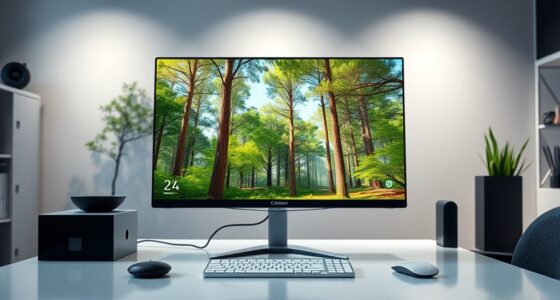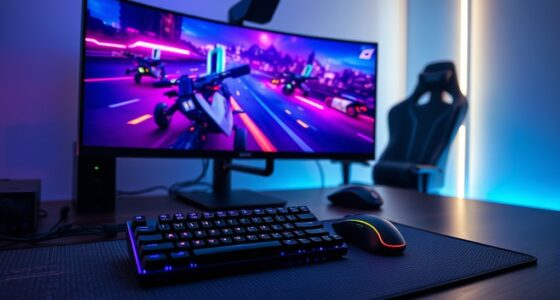Before you start, it’s key to understand that a 120Hz refresh rate updates your display 120 times per second, providing smoother motion and reducing blur. Variable Refresh Rate (VRR) adjusts the refresh rate dynamically to match your device’s frame rate, eliminating tearing and stuttering during gameplay. Fine-tuning these settings enhances your viewing and gaming experience. Keep going to discover how to optimize your display for maximum performance and clarity.
Key Takeaways
- Ensure your display supports 120Hz refresh rate and VRR technologies like FreeSync or G-SYNC.
- Verify that your graphics card and system can output high frame rates compatible with 120Hz.
- Adjust display settings to enable 120Hz refresh rate and VRR features for optimal performance.
- Disable unnecessary motion smoothing or post-processing effects that may interfere with true refresh rate benefits.
- Test with compatible content or games to confirm smoothness, responsiveness, and proper VRR operation.
Understanding 120Hz Refresh Rate and Its Benefits

A 120Hz refresh rate means your display updates 120 times per second, providing smoother motion and reducing motion blur. This higher refresh rate enhances your viewing experience, especially during fast-paced scenes or gameplay. You’ll notice less choppiness and more fluid motion, making action look more natural. Additionally, a higher refresh rate can help minimize input lag, so your commands register more quickly on screen. You should also be aware that response time impacts how quickly pixels change color, which can affect motion clarity at higher refresh rates. However, some motion smoothing features might interfere with this benefit, creating artificial frames that can cause a soap-opera effect. To truly enjoy the advantages of 120Hz, you should disable unnecessary motion smoothing settings. This way, your display can deliver the smooth, responsive visuals you expect, improving both gaming performance and everyday viewing. Understanding the refresh rate and related settings can help you fine-tune your display for the best experience, especially considering how industry trends influence display technology improvements. Moreover, being aware of color accuracy and contrast ratios can further optimize your viewing setup for immersive entertainment. For optimal performance, consider how gaming-specific features like adaptive sync can complement your 120Hz setup.
Key Points About Variable Refresh Rate (VRR) Technology

Variable Refresh Rate (VRR) technology dynamically adjusts your display’s refresh rate to match the frame rate of your content, which helps eliminate screen tearing and stuttering. It’s a key feature of adaptive sync, ensuring smoother visuals during fast-paced gameplay or videos. Here are some key points to contemplate:
- VRR reduces flicker, providing a more comfortable viewing experience.
- It adapts in real-time, preventing lag between the GPU output and display refresh.
- Compatible with technologies like FreeSync and G-SYNC, enhancing flexibility.
- It’s especially beneficial for gaming, where frame rates can fluctuate rapidly.
- Implementing VRR can also improve headphone compatibility between your hardware components, leading to a more seamless gaming experience.
- Additionally, understanding display refresh rates can help you optimize your setup for the best possible visual performance.
Frequently Asked Questions
Can I Enable 120HZ and VRR Simultaneously on Any Monitor?
Yes, you can enable 120Hz and VRR simultaneously on a monitor if it supports both features. Make sure to check the monitor’s specifications for compatibility testing, as not all displays support high refresh rates with VRR at the same time. Once confirmed, enable both in your display settings or GPU control panel for smoother gameplay and reduced screen tearing.
Do All Gaming Consoles Support 120HZ and VRR Features?
Not all gaming consoles support 120Hz and VRR features. Console compatibility varies, so check your device’s specifications and firmware updates to verify these features are available. For example, newer Xbox Series X and PlayStation 5 models support both 120Hz and VRR, but older consoles may not. Keep your firmware updated, as manufacturers often add support for these features through updates, improving your gaming experience.
How Do I Verify My Device’s Compatibility With VRR?
To verify your device’s compatibility with VRR, check its specifications, support documentation, or settings menu. You should also look for firmware updates, as they often add or improve VRR support. Guarantee your device’s firmware is current, and consult the manufacturer’s website or user manual for compatibility details. This way, you can confidently confirm whether your device supports VRR and enjoy smoother gaming experiences.
Are There Any Downsides to Using 120HZ and VRR?
Using 120Hz and VRR can improve your gaming experience, but there are some downsides. You might notice increased input lag, which can affect fast-paced gameplay, and motion blur could become more apparent at higher refresh rates. Additionally, not all devices handle VRR perfectly, causing potential screen tearing or flickering. Weigh these factors to decide if the smoother visuals outweigh the minor issues for your gaming style.
What Settings Should I Adjust for Optimal 120HZ VRR Performance?
Think of your display as a dance partner, syncing perfectly with your moves. To optimize 120Hz VRR performance, set your refresh rate to 120Hz in settings. Calibrate your color for clarity and vibrancy, ensuring smooth visuals. Disable unnecessary motion smoothing, and enable VRR. These adjustments keep your experience seamless, like a well-choreographed dance, allowing your visuals to flow effortlessly and accurately with every game or video.
Conclusion
Now that you know the basics of 120Hz and VRR, you’re better equipped to enjoy smoother gameplay and sharper visuals. Remember, understanding these features is the key to revealing your display’s full potential. Don’t let confusion hold you back—dive in and get the most out of your gaming and viewing experience. Once you’re up to speed, you’ll see that the devil is in the details, and now you’re ready to master them.















